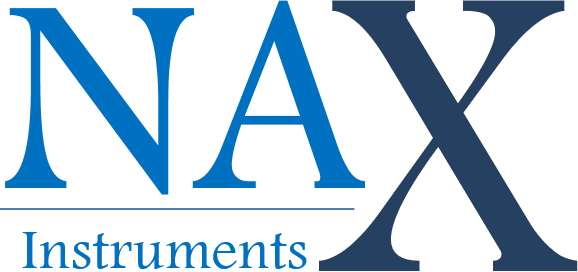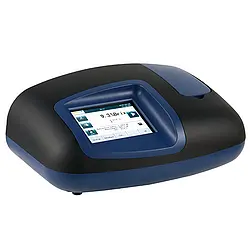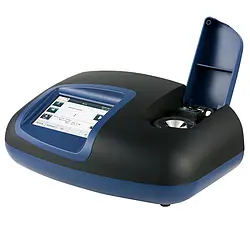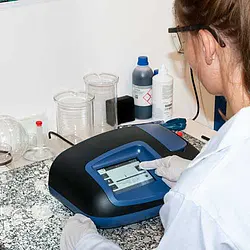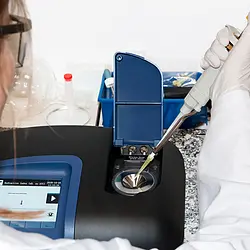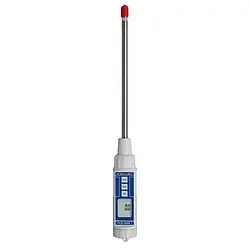Description
Abbe Refractometer
Abbe refractometer for precise measurement of refractive index and Brix / thermostat connection /
large touch screen / measurement data memory 100 places / eight-digit user- and sample-IDs /
RS-232 interface
The digital Abbe refractometer is easy to use and requires only small sample quantities. The digital display prevents reading errors. The results can be stored in the Abbe refractometer, printed or transferred to a PC. The possibility of assigning eight-digit user and sample designations via the menu of the Abbe refractometer facilitates later the evaluation of the measurement results. For each measurement, the measuring temperature is displayed on the touchscreen of the Abbe refractometer so that the temperature-dependent measured values can be converted.
Measuring principle of the digital Abbe refractometer
With the Abbe refractometer, the refractive index as well as the Brix value can be determined precisely. The refractive index relates the wavelength of light in a vacuum to the wavelength of light in the medium being tested.  For this purpose, a high-resolution sensor in the refractometer measures the total reflection of a special light source with a wavelength of 589 nm when the light hits the sample to be checked. The Abbe refractometer is therefore suitable for checking liquid, viscous and also solid samples. The measurement is not dependent on the turbidity, viscosity, transparency or absorption of the sample. After the measurement, the Abbe refractometer displays the refractive index between 1.3000 and 1.7000 nD and the Brix value between 0 and 100 %. In addition to these measuring parameters, the Abbe refractometer has a high reading and measuring accuracy. Due to the possibility of making various settings in the menu, the Abbe refractometer can be adapted to a wide range of needs and requirements. All the settings can be made via a very easy-to-read LED touch screen.
For this purpose, a high-resolution sensor in the refractometer measures the total reflection of a special light source with a wavelength of 589 nm when the light hits the sample to be checked. The Abbe refractometer is therefore suitable for checking liquid, viscous and also solid samples. The measurement is not dependent on the turbidity, viscosity, transparency or absorption of the sample. After the measurement, the Abbe refractometer displays the refractive index between 1.3000 and 1.7000 nD and the Brix value between 0 and 100 %. In addition to these measuring parameters, the Abbe refractometer has a high reading and measuring accuracy. Due to the possibility of making various settings in the menu, the Abbe refractometer can be adapted to a wide range of needs and requirements. All the settings can be made via a very easy-to-read LED touch screen.
Abbe refractometers are devices that use optical rules to determine the refractive index. Light can be diffracted, reflected or absorbed when passing from one medium to another. This Abbe refractometer uses the reflection principle. The reflection takes place at the boundary layer between the prism and the sample. Since the light does not have to pass through the sample, this Abbe refractometer measures independently of the turbidity, viscosity or transparency of the sample.
The sample is placed on the prism in the measuring chamber of the Abbe refractometer. The lid of the measuring chamber must be closed to avoid the measurement errors due to extraneous light. After starting the measurement, the internal light source of the Abbe refractometer sends light beams through the prism onto the boundary layer between the sample and the prism. These light beams are completely reflected from a certain angle. The optical sensor of the digital Abbe refractometer detects these reflected rays. By means of evaluating the illuminated sensor areas, the Abbe refractometer calculates the refractive index of the sample. The refractive index of the prism used in the Abbe refractometer must be greater than the refractive index of the sample. The prism used therefore determines the upper measuring range limit of the Abbe refractometer.
The measuring range of this Abbe refractometer is 1.30000 nD to 1.70000 nD. The D stands for the wavelength of the light used in the measurement with 589.3 nanometres wavelength. The refractive index depends not only on the type of light but also on the temperature. As the temperature increases, the refractive index decreases. To make the highly accurate results possible, many Abbe refractometers have tube connections for temperature control.
Determination of the the Brix value with the Abbe refractometer
There is a direct relationship between refractive index and Brix value. Therefore, instead of the refractive index, the Brix value can also be determined very accurately with this digital Abbe refractometer. The Brix value is the most frequently used unit for measuring sugar concentration worldwide and is very often determined with the Abbe refractometer. It is defined by the sucrose content in water.
At 1 °Brix = 1 %Brix, 100 g of solution contains 1 g of sucrose in 99 g of water.
At 12 °Brix = 12 %Brix, 100 g solution contains 12 g sucrose in 88 g water.
The Brix value is often used as a test value – also for samples not containing sugar – because it is easier to compare than the refractive index. For example, at 20°C measuring temperature
2 %Brix = 1.33586 nD, 12 %Brix =1.35093 nD, 30 %Brix = 1.38115 nD and 60 %Brix = 1.44193 nD.
Calibration and adjustment of the Abbe refractometer
Each time the Abbe refractometer is started, a calibration is automatically carried out. The calibration guarantees an error-free measurement; the calibration is completely automatic and is carried out by the measuring instrument itself. Alternatively, the calibration can also be carried out at any time during use. For ISO or DAKKS calibration, you can send the Abbe refractometer to an accredited test laboratory. There, it will be calibrated using certified standards and a calibration certificate will be issued for the Abbe refractometer. With the certificate you are able to prove the measuring accuracy and the test intervals.
With standard solutions for different refractive indices, the user can regularly check the measuring accuracy of the Abbe refractometer himself. If the results deviate too much despite the controlled temperature conditions, the Abbe refractometer can be adjusted. To do this, one may call up the calibration function in the menu of the Abbe refractometer and enter the refractive index of the standard solution used. The Abbe refractometer is then adjusted to this standard solution.
Measurement data storage in the Abbe refractometer
The measurement data determined by the Abbe refractometer can be transferred to a PC via the RS232 interface or stored directly in the Abbe refractometer on the 100 memory locations. For later analysis, these measurement data are read out on the touch screen of the Abbe refractometer via a sample number and a user number in the system in such a way that they can be retrieved again according to user ID, sample ID or date or transferred to the other data carrier. It is also possible to read out the measured value data via PC software to facilitate further documentation. Also on the Abbe refractometer, the stored measurement values can be filtered by date or by user or sample number. To avoid falsification of the measurement values by ambient light sources such as daylight, incandescent lamps or fluorescent lamps, the sample flap on the top of the Abbe refractometer must be closed. Since the refractive index is temperature-dependent and this should be constantly taken into account for the precise measurement, constant ambient temperatures are important for the comparative measurements, ideally in the range around 20 °C.
The refraction of light depends strongly on the wavelength of the light and, depending on the liquid, also on the temperature. Ideally, therefore, the measurements with the Abbe refractometer should be carried out at constant temperature conditions around +20 °C. If, for example, measurements are to be carried out at the boiling temperature of the substance to be checked, the standard temperature is invalid. The unit used to represent the refractive index is the nD. The subscript “D” represents the reference wavelength of the light source, which refers to the sodium D-line at 589nm. Due to the wavelength dependence of the refractive index, the measurement must be made with monochromatic light. In some cases, the temperature at which the measurement was carried out is also indicated as a superscript to make it easier to understand the ambient conditions during the measurement.
PC software for the Abbe refractometer
The data from the memory of the Abbe refractometer can be read out with the corresponding PC software. The measured values transmitted via the RS232 interface of the Abbe refractometer are displayed as a table. This data can be exported completely or partially as a CSV file. The table contains:
No. / date / time / user ID / sample ID / measured value / unit nD or %Brix /measured temperature.
The data memory in the Abbe refractometer can also be deleted via the software, so that 100 memory locations are free again and no data is read out twice.
Accessories for the Abbe refractometer for special liquids
To avoid measuring errors caused by extraneous light, the lid of the sample chamber of the Abbe refractometer must be closed. For special liquids, special lids are available for this Abbe refractometer. The lid for highly viscous liquids presses the sample against the prism surface of the Abbe refractometer due the installed additional element. In the lid for volatile samples, the additional element is equipped with a sealing ring. This sealing ring prevents evaporation of the liquid during temperature equilibration and measurement in the Abbe refractometer. Evaporation would lead to a change in concentration in the sample to be measured and thus to incorrect results.
Abbe refractometer application areas and what it is used for
Abbe refractometers are widely used because they allow the refractive index to be measured quickly and easily.  Often the refractive index is used to test the purity of a substance. For many mixtures of two substances, there is a clear correlation between the refractive index and the composition. The Abbe refractometer thus makes it possible to determine the content of a certain substance in a solvent easily via the refractive index. In the case of substance mixtures that are subject to certain variations, for example honey with varying water content, a range can often be specified for the desired refractive index. Compliance with these values can be checked with the Abbe refractometer.
Often the refractive index is used to test the purity of a substance. For many mixtures of two substances, there is a clear correlation between the refractive index and the composition. The Abbe refractometer thus makes it possible to determine the content of a certain substance in a solvent easily via the refractive index. In the case of substance mixtures that are subject to certain variations, for example honey with varying water content, a range can often be specified for the desired refractive index. Compliance with these values can be checked with the Abbe refractometer.
Abbe refractometers in the chemical, automotive, metal and building industries
enable concentration determination for solvents, mordants, industrial oils, lacquers, adhesives, surfactants, coolants and the check of the flow of chemical processes during the production.
Abbe refractometers in sugar, food and beverage industry
are used to determine the sugar concentration in intermediate and end products, to determine the alcohol content in beer, wine, spirits, quality control and for waste water control.
Abbe refractometers in medicine and pharmacy
allow for fast analysis of body fluids, purity control of raw materials, intermediate and end products e.g. for infusion solutions, dialysis preparations.
Concentration determinations of raw, auxiliary and operating materials as well as semi-finished and finished products are then carried out. Checking the solids content is extremely important in many industries in development, research and production and is often carried out with the help of the Abbe refractometer. In the beverage industry, checking the sugar content and sugar concentration is a very important measure and is therefore a part of routine analysis.
Many applications aim to determine the concentration in a carrier medium. A traditional example is the determination of the sugar content in mostly aqueous solutions. For example, by determining the sugar concentration of a grape, its degree of ripeness can be determined, which makes it interesting for winemakers. The Abbe refractometer can also measure the original wort when brewing beer, the water content in honey. But also in industry, the Abbe refractometer can be a real aid, for example, thus, the oil-water concentration in cooling emulsion mixtures in metalworking machines or the acid concentration in batteries can be determined. The Abbe refractometer can also be found in medicine, for example, the protein content in urine can be measured. There are many other areas of application in which the refractometer is useful and greatly simplifies the work. Meanwhile, in order to ensure the comparability of the results, own scales have been established (degrees Oechsle, degrees Brix, degrees Plato). Refractometers are usually equipped with the double scale % mas sucrose (Brix)/°Oe or triple scale % mas sucrose (Brix)/°Oe/KMW-Babo. Internationally, the % mas sucrose (Brix) scale is valid. The Oechsle scale 0-140°Oe is valid for fruit juices, foreign grape musts and distilling mashes. For German grape musts only the Oechsle scale 30-140°Oe is valid. Refractometers with this scale are marked with a “D”.
Adjustment and calibration
In order to meet and maintain the test criteria or test intervals specified in your company’s test equipment manual, it is possible to send the Abbe refractometer to the PCE Instruments test and calibration laboratory at any time. The Abbe refractometer is then calibrated using certified standards and an ISO calibration certificate is issued at the same time, so that you are always in a position to comply with the specifications stated in the technical data of the device and to prove the measurement accuracy during an audit. In addition, standards for different refractive indices are optionally available, with which the measuring accuracy of the refractometer can be regularly checked directly in operation.
The Abbe refractometer PCE-DRB 10 is a modern, highly accurate, data-capable and cost-effective measuring instrument for multifunctional analysis of a wide range of parameters such as refractive index or Brix value and is therefore indispensable for all company and public laboratories working in the field of analysis.
Interesting facts about the Abbe refractometer
How does an Abbe refractometer work?
The Abbe refractometer serves as a measuring instrument with which you can determine the refractive index. This works for both liquid and solid substances, as long as they are transparent, with the help of refractometry. After the sample has been applied to the Abbe refractometer, special optics in the refractometer creates the opposite light-dark fields; the borderline between the two fields is the measurement result of the sample.
Roughly, one can differentiate between three measuring methods of the Abbe refractometer:
– Transmitted light
– Grazing incidence
– Total reflection
Refraction, i.e. the total reflection of light and its physical properties, is used for this purpose. The common denominator of the three measuring principles presented is the measuring prism with a known refractive index. Light has the property that it does not move at the same speed at the transition between the measuring prism and the sample medium, but propagates at different speeds. The unknown refractive index of the medium to be measured is measured via the light deflection.
– In the case of the transmitted light principle, a parallel beam of light is refracted at the interface of both media.
– In the case of the grazing incidence and total reflection, the critical angle of a beam of rays with different angles of incidence on the interface is measured.
The measurement result is most accurate at 20 °C, therefore the temperature should always be determined and the falsified measurements should be corrected with the help of a correction table. In this Abbe refractometer, however, an automatic temperature correction takes place, which of course greatly increases the measuring comfort.
Abbe number
The classification of lenses (e.g. lenses for glasses or technical plastics) is done, for example, by means of the Abbe number. The number was named after its inventor Ernst Karl Abbe (Jena) and it is an individual dimensionless glass constant. Simplified, the Abbe number represents the ratio between the light scattering of different wavelengths and the corresponding refractive index (how the refractive index changes in relation to the wavelength). The number also characterises the finest distribution (dispersion) of the glasses. The greater the dispersion is, the smaller the Abbe number is. There is a clear relationship between the glass quality and Abbe number: high number = high quality. The dispersion of plastics is also determined with the Abbe refractometer.
– measures refractive index and Brix value
Specification
| Measuring range refraction index | 1.3000 … 1.7000 nD |
| Resolution | 0.0001 nD |
| Accuracy | ± 0.0001 nD |
| Measuring range sugar content | 0 … 100% |
| Resolution | 0.1% |
| Accuracy | ± 0.1% |
| Measuring range thermometer | 0 … 95°C / 32 … 203°F |
| Resolution | 0.1°C / 0.18°F |
| Accuracy | ± 0.3°C / 0.54°F |
| Further technical specifications of the Abbe refractometer | |
| Memories | 100 |
| Interface | RS-232 |
| Wavelength | 589 nm |
| Ambient temperature | 10 … 35°C / 50 … 95°F |
| Storage temperature | -20 … 60°C / -4 … 140°F |
| Mains voltage | 100 … 240V AV, frequency 50/60 Hz |
| Weight | 4 kg / 8.8 lbs |
| Dimensions | 360 x 240 x 150 mm / 14.2 x 9.4 x 5.9 in (L x W x H) |
| Calibration | Single-point calibration |
| Display | 5.6″ LED touch screen |
Delivery Scope
1 x Power plug
1 x User manual
